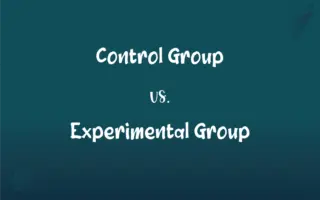Auxin vs. Gibberellin: What's the Difference?
Edited by Aimie Carlson || By Harlon Moss || Updated on October 29, 2023
Auxins are plant hormones promoting cell elongation and growth, while gibberellins stimulate stem elongation, seed germination, and flowering.

Key Differences
Auxins are hormones that regulate plant growth, particularly by promoting cell elongation in stems. Gibberellins are a group of hormones that primarily stimulate stem and overall plant growth.
Auxin plays a pivotal role in the phototropism of plants, directing growth towards light. Gibberellin is crucial for breaking seed dormancy and promoting germination.
In root development, auxin stimulates root initiation and growth. Gibberellin, on the other hand, can inhibit root growth while promoting shoot elongation.
Auxins are involved in the formation of lateral and adventitious roots. Gibberellins play a significant role in fruit development and ripening.
The synthesis of auxin occurs in the stem tips and then migrates to different plant parts. Gibberellins are synthesized in various plant parts, including roots, young leaves, and developing seeds.
ADVERTISEMENT
Comparison Chart
Primary Function
Promotes cell elongation and plant growth
Stimulates stem elongation, germination, flowering
Role in Phototropism
Directs plant growth towards light
Less involved in phototropism
Impact on Roots
Stimulates root initiation and growth
Can inhibit root growth
Synthesis Location
Produced mainly in stem tips
Synthesized in roots, leaves, and seeds
Role in Seed Germination
Less involved in breaking seed dormancy
Crucial in breaking seed dormancy and promoting germination
ADVERTISEMENT
Auxin and Gibberellin Definitions
Auxin
Plant hormone regulating growth and development.
The application of auxin stimulated the plant's stem growth.
Gibberellin
Hormone affecting plant growth patterns.
The presence of gibberellin altered the growth pattern of the dwarf plant.
Auxin
Involved in root formation and growth.
Increased auxin levels resulted in more root development.
Gibberellin
Involved in breaking seed dormancy.
The application of gibberellin triggered seed germination.
Auxin
Influences plant phototropism.
Auxin accumulation on the shaded side caused the plant to bend towards light.
Gibberellin
Influences enzyme production in germinating seeds.
Gibberellin induced the production of amylase in germinating barley seeds.
Auxin
Hormone essential for plant tissue differentiation.
Auxin was applied to encourage the formation of callus in tissue culture.
Gibberellin
Plant hormone stimulating stem elongation.
Gibberellin treatment caused the plant's stem to grow taller.
Auxin
A hormone promoting cell elongation.
Auxin played a key role in the plant's response to light.
Gibberellin
Promotes flowering and fruit development.
Gibberellin application advanced the flowering time in plants.
Auxin
Any of several plant hormones that regulate various functions, including cell elongation.
Gibberellin
Any of several plant hormones, such as gibberellic acid, that stimulate stem elongation, seed germination, and other physiological processes.
Auxin
(botany) A class of plant growth substance (often called phytohormones or plant hormones) which play an essential role in coordination of many growth and behavioral processes in the plant life cycle.
Gibberellin
(hormone) Any of a class of diterpene plant growth hormones first isolated from the fungus Gibberella fujikuroi.
Auxin
A substance which, in small concentrations, promotes root formation, bud growth, or certain other processes such as fruit ripening or leaf drop in plants.
Gibberellin
Any of a number plant growth hormones, the first of which was isolated in 1938 from the fungus Gibberella fujikuroi; more than 60 related gibberelins are known. The most important is gibberellin A3, also called gibberellic acid. They are used in agriculture for promoting plant growth.
Auxin
A plant hormone that promotes root formation and bud growth
Gibberellin
A plant hormone isolated from a fungus; used in promoting plant growth
FAQs
What is gibberellin?
Gibberellin is a plant hormone that stimulates growth, particularly stem elongation.
How does gibberellin affect seed germination?
Gibberellin breaks seed dormancy and promotes germination.
Can auxin influence root development?
Yes, auxin stimulates root initiation and growth.
Where are gibberellins synthesized in plants?
Gibberellins are synthesized in roots, young leaves, and developing seeds.
Can gibberellin affect flowering and fruit development?
Yes, gibberellin can promote flowering and fruit development.
How do auxin and gibberellin differ in function?
Auxin promotes cell elongation, while gibberellin stimulates overall growth and germination.
How is synthetic auxin used in agriculture?
Synthetic auxin is used as a herbicide and to promote fruit growth without fertilization.
What is the effect of gibberellin on grape production?
Gibberellin is used to increase grape size and improve fruit quality.
How does auxin affect plant tissue culture?
Auxin encourages callus formation and differentiation in plant tissue culture.
Is auxin involved in plant response to gravity?
Yes, auxin plays a role in gravitropism, helping plants grow in the direction of gravity.
Is auxin transport directional in plants?
Yes, auxin is transported directionally, influencing growth patterns.
Can gibberellin be used to treat dwarfism in plants?
Yes, gibberellin treatments are used to counteract dwarfism in certain plants.
What happens if a plant has too much auxin?
Excess auxin can lead to abnormal growth patterns and inhibit root growth.
Can gibberellin be used to alter plant height?
Yes, gibberellin can be used to increase plant height, especially in dwarf varieties.
Does auxin have a role in wound response in plants?
Auxin can be involved in the wound response, directing growth and healing.
Can both auxin and gibberellin be artificially synthesized?
Yes, both hormones can be synthetically produced for agricultural and research purposes.
What role does auxin play in phototropism?
Auxin directs plant growth towards light by promoting cell elongation on the shaded side.
Does gibberellin influence plant enzyme production?
Gibberellin can influence the production of enzymes, particularly in germinating seeds.
What is auxin?
Auxin is a plant hormone that regulates growth and development.
Does gibberellin have an effect on root growth?
Gibberellin can inhibit root growth while promoting shoot elongation.
About Author
Written by
Harlon MossHarlon is a seasoned quality moderator and accomplished content writer for Difference Wiki. An alumnus of the prestigious University of California, he earned his degree in Computer Science. Leveraging his academic background, Harlon brings a meticulous and informed perspective to his work, ensuring content accuracy and excellence.
Edited by
Aimie CarlsonAimie Carlson, holding a master's degree in English literature, is a fervent English language enthusiast. She lends her writing talents to Difference Wiki, a prominent website that specializes in comparisons, offering readers insightful analyses that both captivate and inform.
































































